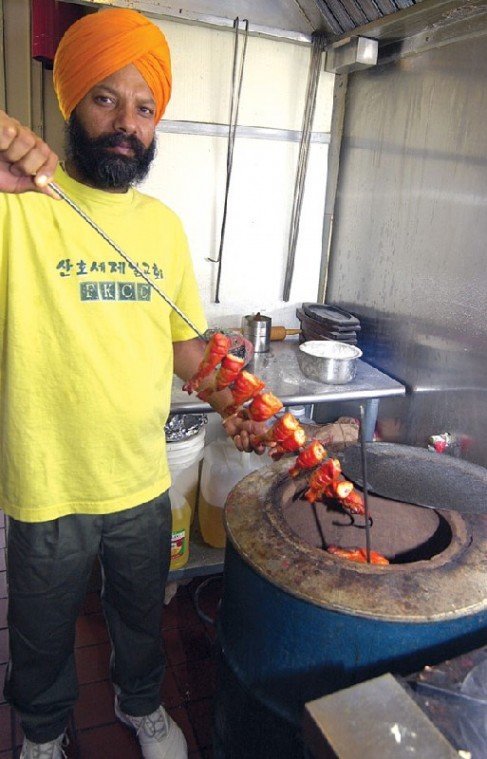n by Melania Zaharopoulos
Staff Writer
Rich, warm-colored spices glow in the yellow light of Parmaji Nijjar’s kitchen at Indian Curry House in Morgan Hill. The bright reds, dusky oranges and deep yellows of chili powder, masala and curry convey their savory flavors to the eye just as their rich aromas do to the sense of smell.
Here, Nijjar cooks up Northern Indian cuisine – sweeter and less spicy than its southern counterparts. Like many other Indian restaurants in the United States, his menu includes extensive lists of meat dishes, but it’s not the way most Indians eat, he said.
“They have the meat dishes in India, but only rich people really eat this stuff,” said Nijjar, who spoke in Punjabi with his daughters Ramanpreet, 12, and Jasmine, 14, translating. “It’s not religion, it’s cost, but people who come to the U.S. eat it more.”
Lentils, vegetables, cottage cheese and beans are mainstays of the vegetarian cuisine with spinach, potatoes, onions and tomatoes playing major parts in most dishes.
Indian cuisine served in most restaurants around the world is actually northern Indian cuisine, since the Hindu religion – the religion of choice for the bulk of the southern subcontinent – considers cooking and serving food to strangers “unclean,” according to Madhur Jaffrey, author of “A Taste of India.”
Northern Indian food, less so than its southern counterpart, is also considered fusion food, of sorts. Over the centuries, Arians, Moghuls and Greeks have influenced the cuisine, as have people from China, Portugal and Britain, through trade, conquest and travel.
Religion, though, has had the greatest impact on the area’s cuisine.
“The food of India has its root in the traditions dictated by the ancient Hindu text, the Ayurveda,” wrote MIT research student Alice Moy in the article “Influences in Modern Indian Cooking.” “Before the invasion of the Moghuls, the food of India was very much shaped by the Hindu belief that eating and spiritual advancement are intertwined. Vegetarianism, and especially the avoiding of beef in particular, is part of the Hindu philosophy.”
In the country’s northern half, small children eat mild dishes like navrattan korma, a mixture of seasonal vegetables in a creamy sauce, while adults gravitate toward the more spicy flavors of dhal makhani – Indian-style lentils – and palak paneer – fried bits of a blend made from fresh spinach, masala and homemade cottage cheese. But the real backbone of northern cuisine is the bread: wheat-based naan, chappathi and pooris, wrote Moy.
Sweets in the region, heavy on milk production, are often milk-based themselves, unlike the sugar and cocoa confections found stateside. Lassi, or iced buttermilk, is a favorite drink, according to the cooking resource site IndiaFoodsCo.com, and sweet squares of barfi are a treat made from milk simmered for hours until it thickens into a hard custard, said Nijjar. Other popular desserts include rice pudding and milk balls cooked in rose syrup known as gulab jamun.
To try a bit of what the region has to offer in your own back yard, visit Indian Curry House, located at 110 Cochrane Plaza in Morgan Hill. The restaurant, which serves food prepared fresh each day, is open 11am to 9pm seven days a week, and serves luncheon buffets Monday through Friday. For more information, call (408) 782-0326.
For the more adventurous of heart, Nijjar has offered up two of his personal recipes, though some of the ingredients may be hard to find in a regular grocery store. If you plan to try them, he suggests you do your shopping at Indian Spice House, 90 E. 2nd St., Morgan Hill.
Aloo Pakora
Yield: 15 pieces
1 potato, sliced into 15 pieces
1 cup chickpea flour
1 tsp. mixed masala
salt to taste
water
corn oil
Step 1: Mix chickpea flour with salt and mixed masala, then add water until mixture forms a thin paste.
Step 2: Coat potato pieces in mixture and fry in corn oil.
Tandoori Chicken
8 lbs. chicken legs
20 grams vinegar
20 grams garlic and ginger mix (see below)
10 grams black salt
100 grams plain yogurt
Yellow food coloring to discretion
Step 1: Mix all ingredients together in a large bowl or Tupperware. Let stand in refrigerator overnight.
Step 2: Rack chicken legs on rotisserie and cook in a tandoori oven (in a closed barbecue if you don’t have one) at 400 degrees for 30 minutes.
Garlic and
ginger mix
Peeled and dice fresh ginger and combine in equal parts with whole garlic cloves. Place ginger and garlic in food processor until blended to a smooth consistency and measure 20g of this mixture for tandoori chicken.













